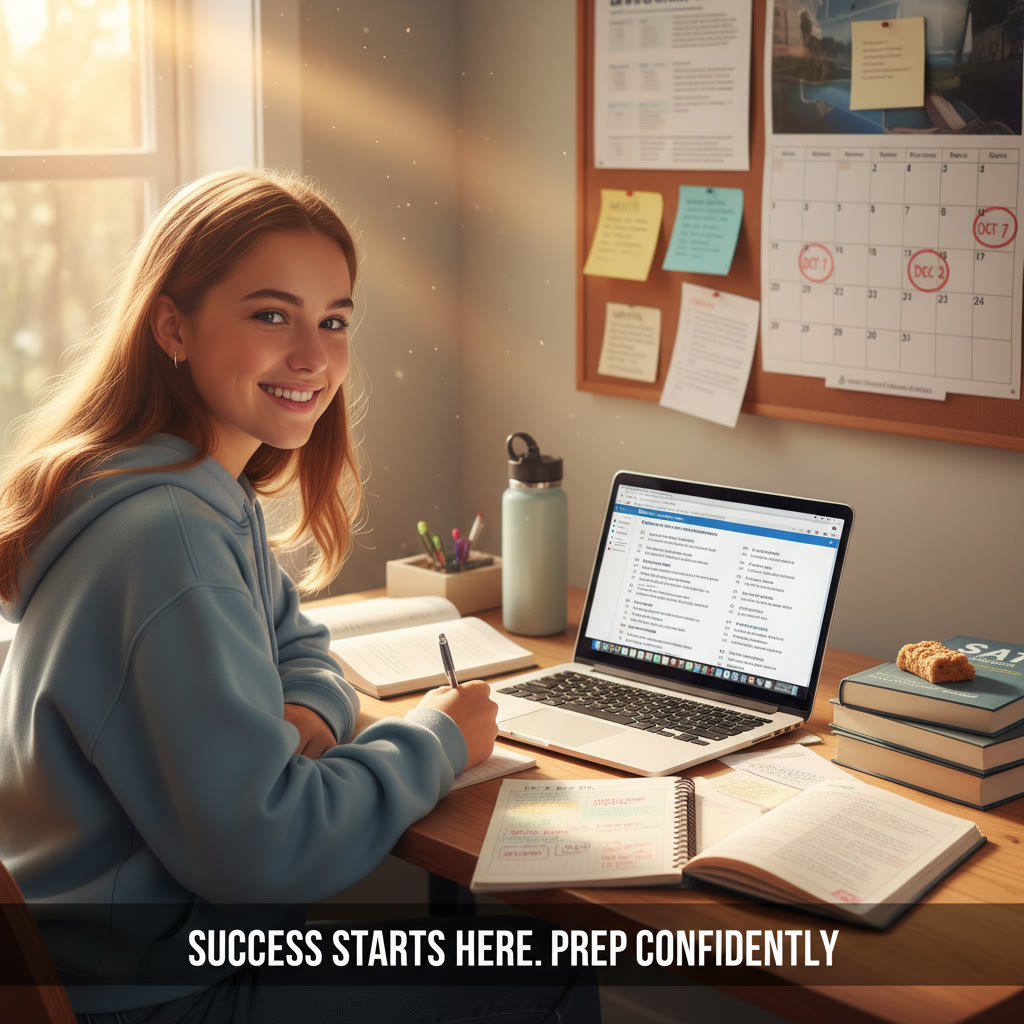Why this matters: SAT and your UIUC application
Planning for college can feel like juggling a dozen important things at once: grades, activities, essays, recommendations — and the SAT. For many students aiming at the University of Illinois Urbana-Champaign (UIUC), understanding how the SAT fits into the admissions picture is one of the most practical moves you can make. With the right information and a realistic plan, the test becomes less of a looming mountain and more of a checkpoint on the way to an Illini offer letter.
Below you’ll find an up-to-date, student-friendly road map: what UIUC typically expects from SAT scores, how test policies are interpreted, what a competitive score looks like, and how to structure your Digital SAT prep (including a note about how Sparkl’s personalized tutoring can fit into that plan).

Current SAT context at UIUC — the headline numbers
When we look at recent admitted-student data to set goals, three quick facts are most helpful: the middle 50% SAT range of enrolled students, the acceptance rate as a sense of selectivity, and the university’s stance on test submission. For UIUC, the commonly reported middle 50% SAT range is roughly 1390–1510 on the 1600 scale. That range gives a concrete target: if your score lands in or above that band, you’ll be comfortably within the profile of a typical admitted student. If it’s below, a strong application in other areas can still make you competitive. The university’s overall acceptance rate sits around the low 40s percent, so applications are selective but not off-the-charts competitive.
Admissions offices often treat the SAT as one component among many; it complements grades, curriculum rigor, essays, and extracurriculars. That means a stronger SAT score can meaningfully improve an application, and if a student’s score is weaker, other strengths (rigor of coursework, sustained activities, excellent essays) can balance that out. For families who are debating whether to submit a score, it helps to compare your real score to the stated middle 50% range for UIUC and to think strategically about scholarship considerations that sometimes depend on scores.
Note: Colleges occasionally refine how they use test scores (for admissions, scholarships, or program placement), so it’s wise to check the latest official statements when you apply.([bigfuture.collegeboard.org]( “middle 50% SAT range” really means
That 1390–1510 is the interquartile range: 25% of admitted students scored below 1390, 25% scored above 1510, and half scored between those numbers. It’s not a strict cutoff — think of it as the score bracket where many students fall. If your score is inside or above this range, your SAT strength will align with many admitted students; if below, you’ll want to emphasize other application strengths or consider retesting if you can improve with targeted prep.
Understanding UIUC’s test policy (test-optional, test-flexible, or required?)
In recent application cycles many universities experimented with test-optional policies and some have adjusted those choices in the years following. For UIUC, the official guidance for applicants typically states that SAT/ACT scores are considered if submitted rather than strictly required. This means applicants may choose whether to send scores, and admissions officers will use them as supplementary evidence of academic readiness when provided.
Practically, that means:
- If your SAT score is at or above the typical UIUC range, consider submitting it — it strengthens the quantitative part of your profile.
- If your score is below your target range, and you don’t have other academic mitigating circumstances or standout achievements, you might weigh whether not submitting makes your application read more competitively.
- Some scholarships or specific program admissions (for example, highly selective majors) may still look at test scores more closely; if scholarships are important, confirm whether programs you’re interested in consider scores for awards.
Because test policies and scholarship rules can change, confirm the exact policy for the cycle you’re applying to — but the broader strategy above helps most students decide whether to submit scores.([bigfuture.collegeboard.org]( should definitely consider taking or submitting the SAT?
- Students with scores at or above 1390 who want to show quantitative strength or qualify for scholarships tied to testing.
- Students applying to STEM-heavy majors or programs where standardized evidence of math readiness is valued.
- Students who didn’t have strong course access in high school (e.g., fewer AP or honors classes) but can demonstrate readiness through a strong SAT performance.
Setting your score target — realistic and ambitious
Picking a target score is as much psychological as numerical. You want something that stretches your capabilities without causing burnout. For UIUC the safe strategy is to aim for at least the lower bound of the middle 50% (around 1390), with a competitive target near the center or upper bound (1450–1510). An aspirational, standout target would be 1520+.
Here’s a quick breakdown to help you choose:
- Safety target: 1390 — matches the lower middle 50% boundary.
- Competitive target: 1450–1510 — aligns with the middle of admitted students.
- Aspiring target: 1520+ — places you above the typical admitted profile and strengthens scholarship potential.
How to plan your Digital SAT timeline
The Digital SAT (the modern format students take today) follows a cadence of test dates throughout the year. When you plan, work backward from application deadlines: for most students applying to UIUC under Regular Admission, the regular application deadline falls in early January; for Early Action applicants the date is typically in early November. That means taking a final SAT in the fall of senior year is common, but many students prefer a completed testing profile by late junior year to avoid last-minute stress.
Practical timeline example:
- Junior year spring/summer: begin focused prep and take a diagnostic Digital SAT.
- Junior year fall: take or retake the SAT; aim to have a solid score by December if you plan to apply Early Action/Regular Decision the next year.
- Senior year fall: if needed, take a final retake to push scores up before deadlines; otherwise focus on applications.
Early, deliberate planning lets you align test prep with coursework (APs, IB, honors), extracurricular commitments, and application writing so nothing is rushed. Consider scheduling at least two official test attempts so you have time to improve after a full diagnostic and a cycle of targeted practice.([satsuite.collegeboard.org]( study plan: 12 weeks to an improved Digital SAT score
Below is a straightforward 12-week plan that many students can adapt. It assumes a diagnostic score at week 0 and aims for steady, measurable improvement rather than last-minute cramming.
| Weeks | Focus | Weekly Goals |
|---|---|---|
| 1–2 | Diagnostic & Foundations | Take a full practice Digital SAT; identify weak sections; review test structure and timing. |
| 3–5 | Content Building | Daily focused practice: math concepts, evidence-based reading strategies, grammar rules; 3–4 practice sections per week. |
| 6–8 | Strategy and Timing | Work on pacing, question triage, and calculator use; take one full timed practice test every 7–10 days. |
| 9–10 | Targeted Weakness Work | Intensive drills on persistent weak areas (e.g., geometry, sentence structure); error log review; practice test analysis. |
| 11–12 | Polish & Simulated Testing | Two full-length, strictly timed practice tests; light review; rest before test day. |
Study habits that stick
- Short, consistent sessions beat marathon cramming—aim for 45–90 minutes of focused practice most days.
- Keep an error log: review every incorrect question and record why you missed it (content, careless, timing, misread).
- Simulate test conditions for at least two full practice tests: timed, minimal breaks, and no distractions.
- Use official practice material when possible to mirror real test content and scoring.
How to read your Digital SAT subscores and use them
The Digital SAT gives you sectional and subscore detail. Those breakdowns are gold: they show exactly which skill clusters you should emphasize. For example, if subscores show strong algebra but weak problem solving with geometry, dedicate weekly drills to geometry problems and visual reasoning. Admissions officers notice growth trends, so demonstrating a meaningful score increase between test attempts can be persuasive evidence of learning and persistence.
When and how to use Sparkl’s personalized tutoring
Personalized tutoring can change how effective your study time is. For students aiming at UIUC, a tutor who tailors lessons to your official diagnostic and error log helps you improve faster than isolated studying. Sparkl’s personalized tutoring offers one-on-one guidance, tailored study plans, expert tutors, and AI-driven insights that spotlight the most efficient areas for improvement—saving time while boosting score gains. Working weekly with a tutor to target recurring mistakes, adjust pacing, and simulate test conditions is especially helpful in the 6–12 weeks before an official test date.
If you prefer a hybrid approach—self-study for content building and periodic sessions with a Sparkl tutor for strategy and targeted drill work—that often yields strong results. The key is using tutoring to close specific gaps (timing strategies, weak content areas) rather than only general reviewing.
Application strategy: when to submit scores
Deciding whether to submit your SAT score to UIUC is a strategic choice:
- Submit if your score is in or above the middle 50% range—this quantifies readiness and can help with competitive majors or scholarship consideration.
- Consider omitting scores that are well below the typical range if you have strong alternatives: outstanding coursework, exceptional essays, major awards, or strong portfolio items for arts/architecture programs.
- If you’re on the fence, a final retake early in senior year after focused prep can give you more options.
Also remember that some scholarships and program-specific admissions decisions may still rely on submitted test scores, so check program requirements where applicable.
Beyond scores: building a complete application for UIUC
Even with a strong SAT, UIUC admissions evaluate the whole student. Here are the supporting elements that matter:
- Rigorous coursework — AP, IB, honors classes when available.
- Consistent academic improvement — upward trends in grades can offset a lower SAT.
- Compelling personal statements — essays that reveal motivation, growth, and fit for UIUC’s community.
- Meaningful activities — depth and leadership in a few areas is better than a laundry list of shallow involvements.
- Letters of recommendation (if required or recommended by the program) that confirm academic character and potential.
A strong SAT score is a powerful asset, but it’s most effective when integrated into a coherent application narrative: what you’ve accomplished, what you still aim to accomplish, and how UIUC fits into that story.
Example applicant profiles
These composite profiles show how different strengths can combine into competitive UIUC applicants:
- Profile A — STEM hopeful: 1480 SAT, 5 APs (including AP Calculus and AP Physics), math club leadership, strong research internship — competitive for engineering programs.
- Profile B — Balanced applicant: 1410 SAT, rigorous humanities coursework, editor of school newspaper, standout personal essay about community work — fits well with many UIUC majors.
- Profile C — Late bloomer: 1320 SAT, strong upward grade trend junior/senior year, award in state science fair, excellent recommendation — could be competitive, especially with targeted essays and optional test-optional strategy.
Common questions families ask
Q: Is the SAT required for UIUC?
A: Historically UIUC has considered SAT/ACT scores if submitted rather than strictly requiring them. That means the test is optional in many cycles, but still strategically valuable when scores are strong. Because policies can be refined, confirm the official policy for the year you apply.([bigfuture.collegeboard.org]( What if my SAT score is below UIUC’s range?
A: Don’t panic. Use an error log to find weak spots and consider intensive, targeted prep. If improvements are realistic within your timeline, retake the test. If not, emphasize other strengths — rigorous coursework, compelling essays, and meaningful extracurricular impact.
Q: How many SAT attempts are too many?
A: Two to three well-planned attempts is typical. Multiple small, incremental retakes can show improvement, but repeated identical scores suggest diminishing returns. Focus on focused practice between attempts rather than taking many lightly prepared tests.
Checklist: 8 steps for a confident SAT submission to UIUC
- Take a full diagnostic Digital SAT to establish a baseline.
- Compare your score honestly to UIUC’s middle 50% range and your target major’s expectations.
- Create a 12-week study plan that targets your weakest subscores first.
- Use at least two full, timed practice tests under realistic conditions.
- Log errors and revisit the same problem types until accuracy improves.
- Consider targeted one-on-one sessions (for example, with Sparkl) to sharpen strategy and fix persistent mistakes.
- Retake the test at most two times after your diagnostic unless you see clear, data-backed room for improvement.
- Decide whether to submit scores based on where your final score lands relative to UIUC’s range and scholarship needs.
Final thoughts: planning with confidence
The SAT is a measurable piece of your application puzzle. For UIUC applicants, the statistics give helpful targets but don’t tell the whole story. A thoughtful strategy — early diagnostic, focused study, realistic retake planning, and integration with the rest of your application — is the winning approach.
If you want to accelerate progress, personalized tutoring that blends subject expertise with test strategy can make a big difference. Sparkl’s tutors offer one-on-one guidance, tailored study plans, and AI-driven insights that help you spend study time where it matters most. Used wisely, tutoring pairs with consistent practice to turn a “good” score into a “great” one.
Approach the process step-by-step, give yourself room to improve, and treat testing as a chance to demonstrate learning — not a one-off judgment. With a clear plan, the SAT becomes a tool, not an obstacle, on your path to the University of Illinois Urbana-Champaign.

Best of luck — you’ve got this. Start with a diagnostic, pick your targets, build a plan, and ask for help when a tutor or coach can speed up progress. When the application season arrives, you’ll be ready not just to apply, but to present the best version of your academic story.
Key data summary (for quick reference):
| UIUC middle 50% SAT range | Approximately 1390–1510 (1600 scale).([bigfuture.collegeboard.org]( |
| Typical acceptance rate | Roughly 42% (varies by year and program).([bigfuture.collegeboard.org]( |
| Test policy | Scores are considered if submitted; check official cycle policy for updates.([bigfuture.collegeboard.org]( |















No Comments
Leave a comment Cancel